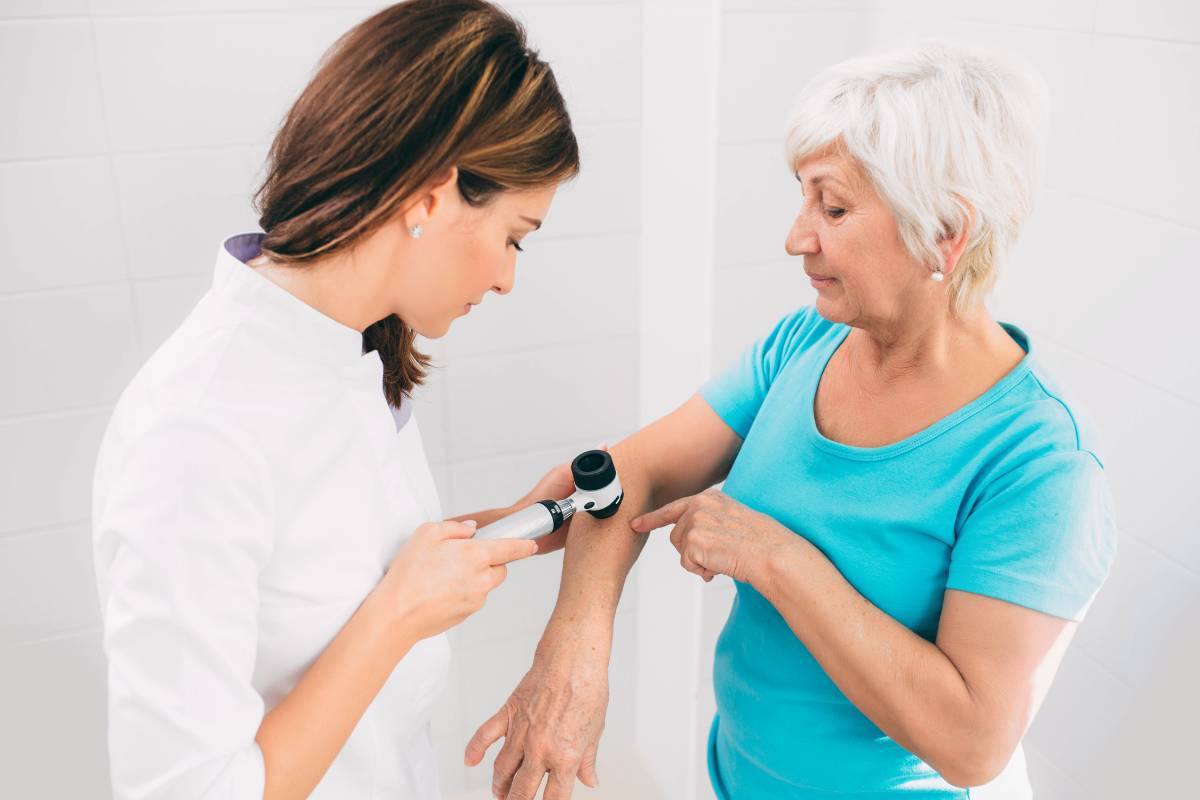How to Become a Dermatology Nurse Practitioner

A dermatology nurse practitioner, also known as a dermatology certified nurse practitioner (DCNP), is a skilled healthcare professional specializing in the diagnosis and treatment of various skin conditions. With a keen eye for detail and a gentle touch, these dedicated clinicians perform routine check-ups and intricate procedures to restore confidence and health.
With only about 0.5% of nurse practitioners (NPs) working in this specialty, now is a great time to join this field. Will you be among those who step up to the challenge? Consider this article your comprehensive guide to launching a career as a nurse practitioner in dermatology care.
Dermatology Nurse Practitioner: Career Snapshot
- Mission: Safeguard skin health.
- Responsibilities: Assess, diagnose, and treat various skin conditions and disorders.
- Workplaces: Specialized clinics, burns units, cosmetic dermatology practices, and skincare clinics.
- Path: Nursing degree and dermatology nursing experience, followed by a master’s degree.
- Length of study: 6 to 8 years.
What Is a Dermatological Nurse Practitioner?
A dermatology NP is a highly specialized healthcare professional who has completed the advanced training and clinical experience required to provide comprehensive care to patients with various skin conditions and disorders. They work closely with dermatologists, aesthetic nurses, and other members of the healthcare team, and sometimes even run their own practices.
Curious about the patients you’ll encounter in this field? Some of the most common skin conditions affecting Americans include:
- Acne vulgaris
- Actinic keratosis
- Benign neoplasm of the skin
- Contact dermatitis
- Epidermoid cyst
What Does a Dermatology Nurse Practitioner Do?
Your exact responsibilities may vary depending on the type of dermatology setting you’re in. Common sub-specialties within this field include:
- General medical dermatology focuses on diagnosing and treating skin conditions and disorders — including acne, eczema, psoriasis, and skin cancer — through non-invasive interventions such as topical creams, oral medications, and light therapy.
- Surgical dermatology involves the surgical treatment of skin conditions, including skin cancer removal, skin grafting, and scar revision, using techniques like excision, cryosurgery, and laser surgery.
- Cosmetic dermatology concentrates on enhancing the appearance of the skin through non-surgical procedures, such as Botox injections, dermal fillers, chemical peels, and laser treatments.
- Teledermatology uses technology, such as video conferencing and digital imaging to enable remote dermatological care, enhancing access to specialized services, especially in rural or underserved areas.
In addition to typical nursing tasks like head-to-toe assessments, medication administration, and documentation, dermatology NP responsibilities can include:
- Collecting tissue samples from suspicious skin lesions for diagnostic purposes.
- Using medical technology to cauterize and remove skin growths and freeze and destroy abnormal skin tissue, such as warts, precancerous lesions, and skin tags.
- Closing wounds and lacerations on the skin using sutures to promote healing and minimize scarring.
- Perform cosmetic procedures, such as laser therapy, chemical peels, and microdermabrasion.
- Conducting comprehensive screenings to detect early signs of skin cancer, including melanoma, basal cell carcinoma, and squamous cell carcinoma.
- Provide patient education on skincare practices, disease management, and prevention measures tailored to their specific condition.
- Collaborate with dermatologists, oncology nurses, and anesthesiology professionals to coordinate care and ensure optimal patient outcomes.
Where Can Dermatology Nurse Practitioners Work?
Dermatology NPs can work in a variety of settings where dermatological care is provided. Here’s where they commonly work:
- Dermatology clinics
- Dermatology units in hospitals
- Burn units
- Medical spas
- Surgical centers
- Research institutions
- Teledermatology services
- Community health centers
- Private practices
Dermatology Nurse Practitioner Schooling
Becoming a dermatology NP is a journey that involves years of education, numerous clinical hours, and several licensure exams. Let’s explore the key steps to get into this meaningful nursing specialty:
1. Earn a Nursing Degree
Begin by earning a nursing degree — either an associate degree in nursing (ADN) or a bachelor of science in nursing (BSN) — from an accredited program. Although a BSN is commonly required for admission into NP programs, nurses may choose to start their careers with an ADN degree. There are bridge programs available to further your education while already working as a nurse.
2. Obtain a Nursing Licensure
Your next important milestone is to obtain your nursing license. This involves successfully passing the NCLEX-RN national examination, which serves as a standardized assessment of your nursing knowledge and competencies. Additionally, you’ll need to fulfill all documentation requirements set by your state’s nursing board.
3. Gain Experience
Before stepping into dermatology nursing, consider getting experience in specialties that can equip you with a broad range of essential nursing skills that will be helpful in dermatology setting, such as:
- Critical care
- Infusion nursing
- Medical-surgical nursing
- Minimally invasive procedures
- Operating room
4. Enroll in a Graduate Program
Your next step is to become a nurse practitioner, which includes pursuing either a master of science in nursing (MSN) or a doctor of nursing practice (DNP) degree. You can choose to become a family nurse practitioner (FNP) first and then pursue dermatology, or enroll directly in the specialty program.
If you choose to dive into the specialty, make sure to select dermatology nurse practitioner programs that are accredited by the Accreditation Commission for Education in Nursing (ACEN) or the Commission on Collegiate Nursing Education (CCNE).
5. Become Board Certified NP
After graduating from your program, you’re set to take the national board certification exam to become a nurse practitioner and apply for a license in your state. The process is often similar to getting an RN license.
6. Become a Dermatology NP
Specialty certification for NPs is administered through the Dermatology Nursing Certification Board (DNCB) and will give you a Dermatology Certified Nurse Practitioner (DCNP) credential. The eligibility requirements are as follows:
- MSN or DNP degree
- NP state licensure
- NP national certification
- 3,000 hours of recent and current work experience as a dermatology NP
How Long Does It Take to Become a Dermatology Nurse Practitioner?
Becoming a dermatologist NP usually takes about six years of schooling at least. Here’s a general timeline:
- BSN — 4 years
- MSN — 2 years
- DCNP — 2 years
How Much Do Dermatology Nurse Practitioners Make?
Although the Bureau of Labor Statistics doesn’t report on dermatology nurse practitioner salary figures specifically, the average NP salary in the U.S. is about $128,490 per year. Your specific income can vary based on factors like your education level, certifications, years of experience, and where you’re located. Here are the top-paying states for NPs:
Becoming a Dermatological Nurse Practitioner: FAQs
Can I become an FNP first and then specialize in dermatology?
Starting as a family nurse practitioner (FNP) is a common pathway for many healthcare professionals. You can then pursue further specialization in dermatology through additional education, training, or certification programs.
Can I work in a dermatology setting as an FNP?
Your training as an FNP equips you with a strong foundation in primary care, which can be applied effectively in a dermatology setting. While it’s possible to find opportunities in certain specialties with an FNP certification, many employers prioritize candidates who have undergone specialized training and hold credentials specific to the field.
What is the job outlook for dermatology NPs?
The job outlook for nurse practitioners is exceptionally positive, as employment in this field is anticipated to increase by 46% over the next decade. This growth rate is significantly higher than the average across all professions.
Dermatology nurse practitioner vs. dermatologist: What’s the difference?
Dermatologists are medical doctors who’ve finished medical school and a dermatology residency and are licensed to diagnose and treat various skin conditions, including surgery and medication prescriptions.
Dermatology NPs, however, are APRNs with graduate training in nursing and dermatology specialization. While they diagnose and treat skin issues, they usually work under a dermatologist’s supervision or in a team setting. Read more about the differences between nurse practitioners and doctors.
Dermatology NP vs. aesthetic nurse: What’s the difference?
A dermatology NP provides comprehensive dermatological care, including medical and cosmetic treatments. An aesthetic nurse primarily specializes in cosmetic procedures to improve skin aesthetics, such as Botox injections, dermal fillers, and laser treatments. An NP can focus on aesthetics as a specialty area. Explore aesthetic NP jobs on IntelyCare to learn more about this type of roles.
Find Your Best Job Match on IntelyCare
Interested in becoming a dermatology nurse practitioner or exploring other specialties? Learn how IntelyCare can match you with nurse jobs tailored to your skills and preferences.


